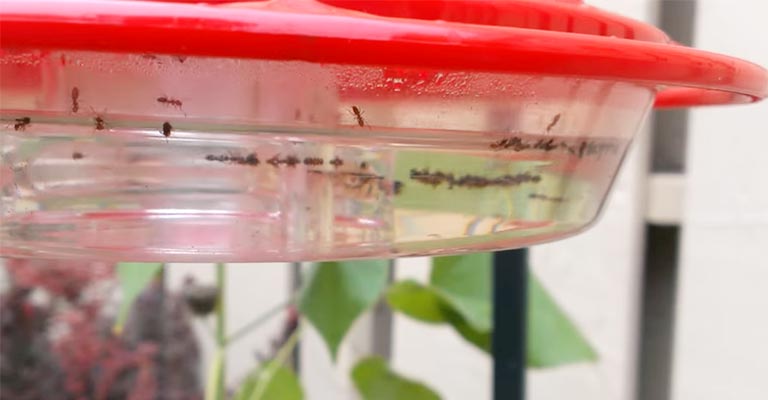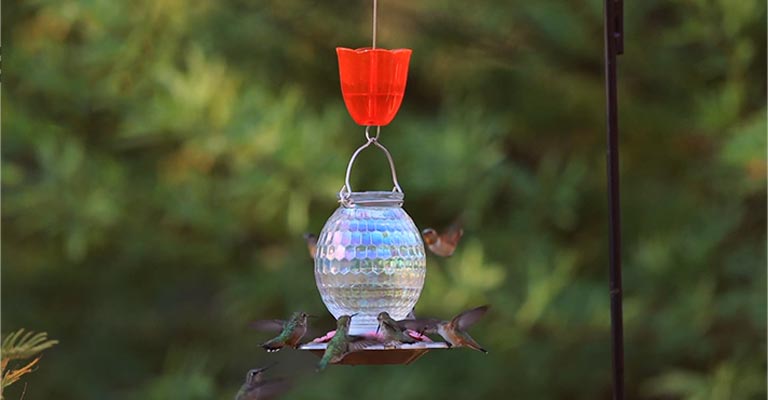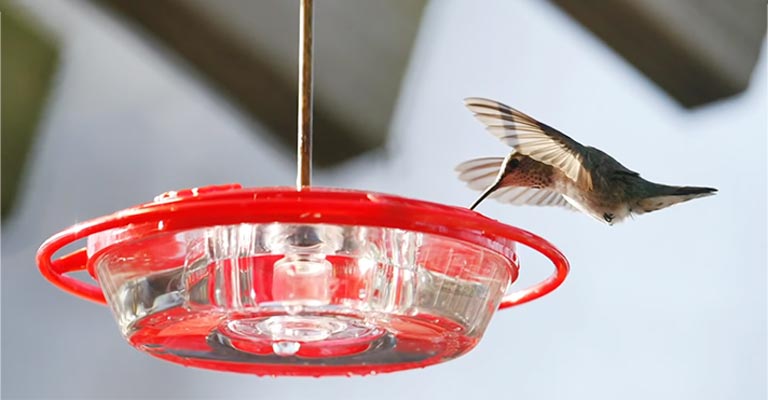If you’re an avid hummingbird enthusiast, you know the joy of watching these tiny, colorful birds flit around your garden.
To attract these feathered wonders, many people invest in hummingbird feeders filled with sweet nectar. However, there’s a common problem that plagues these feeders – ants.
These persistent insects are drawn to the sugary goodness inside the feeder, often frustrating both the birds and the feeder’s owner. So, how to prevent ants in hummingbird feeders?
In this guide, we’ll explore simple yet effective methods to prevent ants from invading your hummingbird feeder. You’ll learn how to protect the nectar while ensuring your feathered friends have uninterrupted access to their food source.
Whether you’re a seasoned bird enthusiast or just starting, our tips will help you maintain a clean and ant-free hummingbird feeder, allowing you to enjoy the mesmerizing presence of these delightful creatures in your backyard.

How to Prevent Ants in Hummingbird Feeders?
Preventing ants in your hummingbird feeder is essential for maintaining a welcoming environment for these charming birds. Hummingbirds are drawn to sweet nectar, and so are ants.
Here, we will explore various methods and strategies to keep ants away from your hummingbird feeder and ensure that your feathered friends can enjoy their meals undisturbed.
Selecting the Right Feeder
The first step in preventing ants in your hummingbird feeder is choosing the right type of feeder. Opt for feeders with built-in ant moats or baffles. These features create a barrier that ants cannot easily cross.
Hummingbird feeders with a built-in moat consist of a small, water-filled chamber located above the feeding ports. This water barrier blocks the ants’ access to the nectar, keeping it ant-free.
Proper Placement
The placement of your hummingbird feeder can greatly affect its vulnerability to ant invasions. Hang the feeder from a hook or branch that is isolated from other surfaces, such as trees or buildings.
This will make it more challenging for ants to reach the feeder. Keep the feeder away from ant trails or known ant-infested areas in your garden.
Ant Moats and Baffles
If your hummingbird feeder does not have a built-in moat or baffle, you can add an external one. Ant moats are small, cup-like devices that you fill with water and attach above the feeder.
Ants will be unable to cross the water barrier to reach the nectar. Baffles are dome-shaped structures that you place above or below the feeder to block ant access. Both of these options are effective in deterring ants.
Keep it Clean
Maintaining a clean hummingbird feeder is crucial in ant prevention. Ants are attracted to the sugary residue that can accumulate on the feeder. Regularly clean the feeder and replace the nectar every 2-3 days, especially in warm weather.
Clean the feeding ports thoroughly, as any nectar residue left behind can attract ants. Use a solution of mild dish soap and water to clean the feeder and rinse it thoroughly.
Choose the Right Nectar Recipe

The nectar recipe you use can make a difference in ant prevention. Some people add extra sugar to make the nectar sweeter, which can be more attractive to ants.
Stick to the recommended nectar recipe of four parts water to one part white sugar. This provides the necessary sweetness for hummingbirds while making it less appealing to ants.
Create a Barrier
Another effective strategy to prevent ants is to create a physical barrier that ants cannot cross. You can do this by applying a sticky substance to the hanging wire or hook of your hummingbird feeder.
Ants will be unable to crawl past the sticky barrier. Use a non-toxic, sticky substance like Tanglefoot, which is specifically designed for this purpose.
Natural Ant Deterrents
Nature provides us with a range of natural ant deterrents that can be employed to protect your hummingbird feeder.
Sprinkle ground cinnamon around the base of your feeder or on the hanging wire. Ants dislike the scent and won’t cross it.
Planting mint around your feeder or using mint-scented cotton balls can help repel ants. Wipe the area around your feeder with a mixture of vinegar and water. The strong odor deters ants.
Check Regularly
Consistent monitoring is essential in ant prevention. Even with the best prevention methods, ants may still find a way to your feeder. Regularly inspect the feeder for any signs of ant activity, and take immediate action to address the issue if ants are present.
Relocation
If ants continue to be a persistent problem despite your efforts, consider relocating your hummingbird feeder to a new spot. Move it to an area that is less accessible to ants. Experiment with different locations until you find one that works best.
Share Your Knowledge
Teaching others about ant prevention for hummingbird feeders can help create a community of bird enthusiasts who can collectively minimize ant intrusions.
Share these tips with fellow bird lovers and neighbors to ensure hummingbirds have a welcoming environment in your area.
Will Vaseline Keep Ants Off Hummingbird Feeder?

Using Vaseline as an ant deterrent around your hummingbird feeder is a practical and budget-friendly solution, but it requires careful consideration and proper application to be effective. Here’s an expanded explanation of the steps and factors to keep in mind:
Selecting the Right Vaseline
When using Vaseline to keep ants away from your hummingbird feeder, it’s crucial to choose the appropriate type. Opt for clear, unscented, and unflavored petroleum jelly like Vaseline.
This choice ensures that the Vaseline won’t introduce any unwanted odors or colors that could discourage hummingbirds from visiting your feeder. Hummingbirds are sensitive to scents and colors, so it’s best to maintain the nectar’s natural appeal.
Applying a Thin Layer
To create an effective ant barrier, apply a thin layer of Vaseline to a specific section of the hanging wire or hook that supports your hummingbird feeder. The objective is to establish a sticky surface that ants will find difficult to cross.
You don’t need to coat the entire hanging apparatus; a strategically applied layer will suffice. Be mindful of the quantity you use; applying too much can lead to a mess and potential issues for both the feeder and the birds.
Reapplication as Needed
Over time, the Vaseline barrier may lose its stickiness due to environmental factors. Dust, dirt, and debris can accumulate on the Vaseline-coated surface, reducing its effectiveness in deterring ants.
Regular inspections are necessary to ensure that the Vaseline remains tacky and efficient in repelling ants. Reapply the Vaseline as required to maintain its barrier function. This proactive approach will help you avoid ant infestations at your hummingbird feeder.
Using Vaseline Sparingly
While it’s essential to create a sufficiently sticky barrier with Vaseline, it’s equally important to apply it sparingly to prevent any mess or issues for the hummingbirds.
A little Vaseline goes a long way in discouraging ants. Too much can lead to unsightly smudges and accidental contact with hummingbirds, which can stress these delicate creatures.
Maintain a delicate balance when applying Vaseline to strike the right equilibrium between effectiveness and aesthetics.
Additional Tips
To ensure effective ant prevention around your hummingbird feeder, combining the use of Vaseline with other proven methods can significantly enhance your success. Here are additional tips to bolster your ant prevention efforts:
Cleanliness
Maintaining a clean hummingbird feeder is fundamental in the fight against ant invasions. Regular cleaning is crucial to remove any sugary residue that could attract ants.
As part of your routine maintenance, disassemble the feeder, wash all components with a solution of mild dish soap and water, and rinse thoroughly. Pay special attention to the feeding ports, as even a tiny bit of remaining nectar can be a magnet for ants.
Adjust Feeder Placement
Experimenting with the placement of your hummingbird feeder can be an effective strategy to make it less accessible to ants.
Try hanging it from a different location, away from ant trails, trees, or buildings. A well-placed feeder can reduce the chances of ants finding their way to the nectar.
Use a Feeder with a Built-In Moat
For a more hands-off approach to ant prevention, consider investing in a hummingbird feeder that includes a built-in ant moat. These specialized feeders feature a small, water-filled barrier located above the feeding ports.
Ants are unable to cross this moat, ensuring the nectar remains ant-free. This option simplifies prevention, as there’s no need to apply external barriers like Vaseline or constantly monitor and clean the feeder.
These feeders are designed with ant prevention in mind and can be a practical choice for bird enthusiasts looking to avoid ant issues altogether.
FAQs
How often should I clean my hummingbird feeder?
Regular cleaning is essential to prevent ant infestations and maintain a safe, healthy environment for hummingbirds. Clean your hummingbird feeder every 2-3 days, especially in warm weather, to remove any sugary residue that might attract ants.
Can I use cooking oil instead of Vaseline to deter ants?
While you can use cooking oil as an alternative to Vaseline, it may not be as effective in creating a long-lasting sticky barrier. Vaseline tends to stay sticky for longer periods, making it a better choice for ant prevention around your hummingbird feeder.
What’s the best way to get rid of ants if they’re already in my hummingbird feeder?
If ants have already infested your hummingbird feeder, remove it immediately, clean it thoroughly, and replace the nectar with a fresh, ant-free solution. Implement prevention methods like Vaseline, natural deterrents, or ant moats to avoid future infestations.
Are there any hummingbird feeder designs that are naturally ant-proof?
Some hummingbird feeders come with built-in ant moats or baffles, creating a barrier between ants and the nectar. Choosing a feeder with these features can be an effective way to prevent ants without needing to use external deterrents like Vaseline.
Are there specific times of the year when ants are more likely to be a problem at hummingbird feeders?
Ant activity around hummingbird feeders can increase during warm weather, especially in the summer months. As temperatures rise, ants become more active and seek food sources, which might include your hummingbird feeder.
Regular maintenance and ant prevention measures are crucial during these periods.
Conclusion
By implementing the strategies outlined in this guide, you can successfully keep ants out of your hummingbird feeder.
From selecting the right type of feeder to employing natural deterrents like cinnamon or mint, there are numerous methods to maintain a pristine nectar supply for your beloved hummingbirds.
By doing so, you’ll create an inviting oasis in your garden that not only attracts these delightful birds but also ensures they can feed in peace without unwanted ant intrusions.
Remember, persistence is key in ant prevention. Regularly monitor and clean your feeder, adjust your strategies as needed, and enjoy the soothing presence of hummingbirds as they grace your outdoor space.
By following these tips, you’ll cultivate an environment where both nature and wildlife thrive, enhancing your connection with the world right in your own backyard. Happy birdwatching!